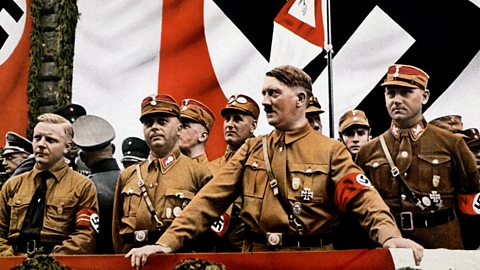The early Nazi Party and its beliefs
Under Hitlerās leadership the Nazi party quickly developed a 25-Point Programme, a list of the policies it would introduce if it came to power.
Key Nazi beliefs contained in the 25-Point Programme:
- A strong Germany - the Treaty of VersaillesThe peace treaty signed by the Allies and Germany at the end of the First World War, on 28 June 1919. should be abolished and all German-speaking people united in one country.
- ¹óĆ¼³ó°ł±š°ł - the idea that there should be a single leader with complete power rather than a democracyA type of government where people govern themselves or elect representatives to govern for them..
- Social Darwinism - the idea that the AryanA person of European descent - not Jewish - often with blond hair and blue eyes. The Nazis viewed Aryans as the superior human race. race was superior and Jews were 'subhuman'.
- Autarky - the idea that Germany should be economically self-sufficient.
- That Germany was in danger - from communistSupporters of the communist movement or party. and Jews, who had to be destroyed.
- Lebensraum - the need for 'living space' for the German nation to expand.
The appeal of the Nazis
In the 1920s, the Nazis tried to appeal to a lot of different members of society. The 25-Point Programme had policies that were:
Socialist
- farmers should be given their land
- pensions should improve
- public industries such as electricity and water should be owned by the state
Nationalist
- all German-speaking people should be united in one country
- the Treaty of Versailles should be abolished
- there should be special laws for foreigners
Racist
- Jews should not be German citizens.
- immigrationThe action of coming to live permanently in another country. should be stopped.
Facist
- focused on creating a strong central government
- government control of the newspapers
Membership and growth
When Hitler joined the German Workersā Party he became its 55th member (his membership card showed 555, as they started counting members from 500 to show they were more popular than they actually were!). By the end of 1920 the newly named Nazi Party recorded a membership of 2,000 and during the upheaval of the hyperinflation crisis its membership grew rapidly, to 20,000 by the time of the Munich PutschA failed attempt in November 1923 by Hitler to overthrow the government of the Weimar Republic. in November 1923.
The role and impact of the SA
In 1921 Hitler assembled a large group of unemployed young men and former soldiers, known as the Storm Troopers (Sturmabteilung) or SA, as the Nazi Partyās private army:
- they gained the nickname āBrownshirtsā, after their brown shirted uniforms
- their role was to protect party meetings, march in Nazi rallies and intimidate political opponents by breaking up their meetings
- after the failure of the Munich Putsch, the SA was reorganized
- it began to be used to intimidate voters into voting for the Nazi Party
- they were led by Ernst Rohm, who would later be killed following the 'Night of the Long Knives', despite helping Hitler win power
By 1932 the SA had 400,000 members. This number swelled to an estimated two million by the time Hitler came to power in 1933, largely due to unemployed men joining up during the The Great DepressionA prolonged economic downturn, beginning after the Wall Street Crash, that affected the whole world..
